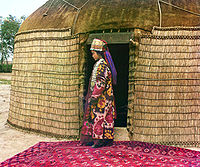Yurt
From Wikipedia, the free encyclopedia
A yurt is a portable, felt-covered, wood lattice-framed dwelling structure used by nomads in the steppes of Central Asia.
Contents |
[edit] Etymology and synonyms
The word yurt is originally from a Turkic word referring to the imprint left in the ground by a moved yurt, and by extension, sometimes a person's homeland or even kinsmen. The term came to be used in reference to the physical tent-like dwellings only in other languages. In Russian the structure is called "yurta" (юрта), whence the word came into English.
The Kazakh word used for yurt Kazakh: киіз үй (IPA: [kɘjɘz ʉj]) means "felt house". The Kyrgyz term is Kyrgyz: боз үй (IPA: [boz yj]), meaning "grey house", because of the colour of the felt. In Turkmen the term is both ak öý and gara öý , literally "white house" and "black house", depending on its luxury and elegance. In Mongolian it is called a Mongolian: гэр (IPA: [ger]). Afghans call them "Kherga"/"Jirga" or "ooee". In Pakistan it is also known as gher (گھر). In Hindi, it is called ghar (घर), which means home. In Persian yurt is called xeyme (خیمه), in Tajik the names are yurt, xona-i siyoh, xayma (юрт, хонаи сиёҳ, хайма).
[edit] Construction
Traditional yurts consist of a circular wooden frame carrying a felt cover. The felt is made from the wool of the flocks of sheep that accompany the pastoralists. The timber to make the external structure is not to be found on the treeless steppes, and must be traded for in the valleys below.
The frame consists of one or more lattice wall-sections, a door-frame, roof poles and a crown. Some styles of yurt have one or more columns to support the crown. The (self-supporting) wood frame is covered with pieces of felt. Depending on availability, the felt is additionally covered with canvas and/or sun-covers. The frame is held together with one or more ropes or ribbons. The structure is kept under compression by the weight of the covers, sometimes supplemented by a heavy weight hung from the center of the roof. They vary regionally, with straight or bent roof-poles, different sizes, and relative weight.
A yurt is designed to be dismantled and the parts carried on camels or yaks to be rebuilt on another site.
[edit] Symbolism
The wooden lattice crown of the yurt (Mongolian: тооно, IPA: [tɔːn]; Kazakh: шаңырақ, IPA: [ʃɑɴərɑ́q]; Kyrgyz: түндүк, IPA: [tyndýk]; Turkmen: tüýnük) is itself emblematic in many Central Asian cultures. In old Kazakh communities, the yurt itself would often be repaired and rebuilt, but the shangrak would remain intact, passed from father to son upon the father's death. A family's length of heritage could be measured by the accumulation of stains on the shangrak from decades of smoke passing through it. A stylized version of the crown is in the center of the coat of arms of Kazakhstan, and forms the main image on the flag of Kyrgyzstan.
Today the yurt is seen as a nationalistic symbol among many Central Asian groups, and as such, yurts may be used as cafés (especially those specialising in traditional food), museums (especially relating to national culture), and souvenir shops.
[edit] Western yurts

Enthusiasts in other countries have taken the visual idea of the yurt -- a round, semi-permanent tent -- and have adapted it to their cultural needs. Although those structures may be copied to some extent from the originals found in Central Asia, they have been greatly changed and adapted and are in most cases very different.
In the United States and Canada, yurts are made using hi-tech materials. They are highly engineered and built for extreme weather conditions. In addition, erecting one can take days and they are not intended to be moved often. Often the designs of these North American yurts barely resemble the originals; they are better named yurt derivations, because they are no longer round felt homes that are easy to mount, dismount and transport. North American yurts and yurt derivations were pioneered by William Coperthwaite in the 1960s[1], after he was inspired to build them by an article about Supreme Court Justice William O. Douglas's visit to Mongolia[2].
In Europe, a closer approximation to the Mongolian and Central Asian yurt is in production in several countries. These tents use local hardwood, and often are adapted for a wetter climate with steeper roof profiles and waterproof canvas. In essence they are yurts, but some lack the felt cover that is present in traditional yurt.
Different groups and individuals use yurts for a variety of purposes, from full-time housing to school rooms. In some provincial parks in Canada, and state parks in several US states, permanent yurts are available for camping.
[edit] See also
| Wikimedia Commons has media related to: Yurts |
[edit] References
- ^ YurtPeople.com - History of North American Yurts, webpage, retrieved February 9, 2007
- ^ Article at Alternatives Magazine on North American Yurts, webpage, retrieved February 9, 2006
[edit] External links
[edit] Background Information
- Information about making yurts into a livable structure including zoning, insurance and site preparation
- Yurt FAQ
- Kazakh Yurta
- yurtinfo.org - A comprehensive resource for yurts and related structures
[edit] Yurt Construction
- Simply Differently.org: Yurt Notes & Calculator, yurt building resources, how-to manuals and online calculator
- How to build a yurt by Paul King (PDF & HTML Book)
- Yurt Building - Documents the complete process of building a yurt from raw materials in pictures and text
- Kazakh Yurt Set-Up by Rebecca Schultz, informative video exposé from Kazakh community in northwestern China.














